- Submissions

Full Text
Archaeology & Anthropology:Open Access
Contact Metamorphism of Calcareous Metasediments of Sausars from Western Balaghat Area of Madhya Pradesh, India and Its Implication in Sausar Stratigraphy
Banerji DC*, Majumder S, Shrivasta RK, Fulmari M and Adhir Kumar Basu
Renaissance Township, India
*Corresponding author: Banerji DC, 21F, SSEA-2, Renaissance Township, Burdwan, India
Submission: July 02, 2018;Published: October 26, 2018

ISSN: 2577-1949 Volume3 Issue4
Abstract
A review of the available literature on Sausars points to a number of disagreements amongst the workers. This includes-Stratigraphic status of Tirodi biotite gneiss; correlation of the low grade phyllite-sericite schist of Bharweli-Ukwa belt; sedimentary versus autoclastic nature of conglomerates and igneous versus metamorphic origin of the amphibolites/granulites, especially of the western part of the belt. Metacarbonate bodies present in the western part of Balaghat district and belonging to Bichua Formation of Sausar Group preserve contact metamorphic assemblages, distributed in distinct zoned aureoles, having lower temperature assemblages in the core and highest temperature assemblages along the periphery. This zonation is more pronounced where metacarbonate lenses are wider. The peripheral area of such lenses are rich in calcite-dolomite-forsterite (serpentinized)-diopsidechondrodite- spinel-tremolite assemblage followed by an intermediate calcite-dolomite-tremolite-biotite-white mica-spinel assemblage and an inner calcite-dolomite-tremolite -white mica-chlorite assemblage. The outer high temperature zone extends for about 250m of width and grades into the intermediate zone of about 500m and finally passes into a core of low temperature assemblages. The high temperature peripheral zones, at places, show presence of dark greyish-green coloured patches with predominance of diopside over calcite/dolomite and accessory quartz, sphene, zoisite, epidote and calcic plagioclases.
These patches, probably representing the special variety of calc-silicates, known as ‘skarns’ [1] are possibly formed by metasomatic interaction between marble and the enclosing biotite gneiss of probable intrusive origin. They have striking mineralogical and textural similarity with the numerously occurring calc silicate lenses present within the surrounding biotite gneiss. Presence of contact metamorphic assemblages in the Sausar metacarbonates, embedded within biotite gneiss of western Balaghat area, and their arrangement in an increasing metamorphic order, from core to periphery, is a clear indication of thermal effect caused by the enclosing biotite gneiss. Additionally, development of calc silicate assemblages at the contact zones and their ubiquitous presence, as lenses, along with the presence of numerous smaller metacarbonates patches, well within the surrounding gneiss further strengthens the possibility of the biotite gneiss being intrusive within the calcareous rocks of Sausar Group.
Introduction
Sir Lewis Fermor, through a series of publications between 1904 and 1909, brought out a detailed account of his “Sausar Series” (phyllite, schists, gneisses, crystalline limestone/marble and calcsilicates/ granulites and associated manganese ore deposits) of Central India. In general, the stratigraphic succession suggested by Fermor [2] and improved upon by West [3] and by Naryanaswami et al. [4] is largely accepted for the gneiss and schist belt of Sausar group of Central India [5]. West (op.cit) suggested that the gneisses of Sausar Group are composite in nature and are produced by the intrusion of igneous material either into the pre-existing igneous rocks or into the metamorphosed sediments belonging to Sausar Group. Straczek et al. [6] included these migmatitic gneisses within the Sausar group, as the basal member, and named them “Tirodi biotite gneiss”. However, Narayanaswami et al. [4] and Shukla & Anandalwar [7] considered the “Tirodi gneiss” to be the basement for the Sausar group with a disconformity between the two.
Furthermore, correlation of the low grade phyllitesericite schist of Bharweli-Ukwa belt and the conglomeratic beds associated with it were also a subject of debate from the beginning. Fermor [2] differentiated the manganiferous low grade metamorphites of Bharweli-Ukwa belt of Balaghat from rest of the Sausars and preferred to call them Chilpi Series. He, however, during his subsequent visits, suggested that this low grade belt could possibly represent a low grade facies of his “Sausar Series”. Fermor, initially, considered the gritty rocks present to the south of the ore horizon as conglomeratic grits of sedimentary origin but reconciled his view after Burton [3,7,8] opined that the part of the grits, along the contact, could be of ‘crush’ origin, formed due to the thrusting of the manganiferous schist belt over the gneiss. Fermor, later, changed his earlier view and suggested the possibility of whole of the gritty conglomeratic formation of Ukwa-Bharweli belt to be of ‘crush’ origin [7]. Narayanaswami et al. [4] (op.cit) included the manganiferous rocks of Bharweli-Ukwa Within the Sausar Group and correlated them with the Mansar Formation. Shukla & Anandalwar [7] favoured the view of Naryanaswami et al. [4] with the rider that this classification is valid till the Chilpi Group is considered to be a low grade equivalent of Sausar Group. They favoured a sedimentary origin for the gritty-conglomeratic zone though; Shukla initially (1950-51) mapped them as crush conglomerates. Jain et al. [9], accepting it to be difficult to decide the origin, have favoured a sedimentary origin for these debatable rocks and considered the manganiferous schist belt of Bharweli- Ukwa, resting over these conglomerates, to be younger to Sausar Group and coined a new name ‘Bharweli Group’ for these rocks.
Also, there remains ambiguity about the origin of calc-silicates/ granulites of the Sausar belt, occurring along the periphery of metacarbonates and within the biotite gneiss. Pascoe [3] refers to the fact that in strike continuity calc-granulites grade into marble, through banded calciphyres. Though, initially it was thought that the rocks were hybrids of calcareous sediment and an acid intrusive; Dr W.D. West later opined that such rocks could be of purely sedimentary origin and the presence of variety of minerals in such cases were presumed to have formed by reactions between the dolomite itself and the original impurities it had. It needs mentioning here that the dolomitic suite of Bichua stage, as mentioned in Pascoe [3] (Op.Cit), contained dolomiticmarbles, forsterite-marbles, spinel-marbles, chondrodite-marbles, diopsidites, tremolite-schists, actinolite-schists, wollastoniteschists, scapolite-granulites and scapolite-diopside-marbles. Later, Subramanyam [10] observed that at many a places amphibolites (of supposedly igneous origin), present in the western part of Balaghat (toposheet 55 O/10), have a gradational relationship with calcsilicates/ granulites and they could be metamorphic variants of marbles and/or calc silicates.
Naryanaswami & Venkatesh [4] also, have reported about the lateral grading of Lohangi marble into the calc gneisses and about the presence of some bands, having close mineralogical and textural similarity to the calc gneisses, within the Tirodi biotite gneiss of the same area. In this paper, the authors intend to highlight certain observations which may help in clearing ambiguity about the origin of the gneisses, calc silicates and the amphibolites associated with the Sausar group. Emphasis, here, is being given on the western part of Balaghat district (toposheet 55 O/10), especially, because of excellent and wide spread exposures of metacarbonates which are otherwise negligible in other parts of Sausars.
Geological Considerations
The rocks of the Sausar Group have been sub-divided [4], in ascending order, into a basal Sitasaongi quartz-muscovite schist and gneiss Formation, followed by Lohangi marble and calc-silicate/ granulite/gneiss Formation, Mansar phyllite and muscovite schist/ gneiss Formation having manganese horizon at bottom, middle and top of the formation, Chorbaoli quartz-muscovite schist/gneiss and quartzite Formation, Junewani biotite-muscovite schist/gneiss and biotite granulite Formation and the youngest Bichua marble and calc-silicate Formation (Figure 1). Tirodi biotite gneiss has been considered to be basement for the Sausar Group and the contact between the two has been taken to be disconfirmable.
Figure 1:Geological sketch map of Sausar rocks of Balaghat (M.P.) area [5].
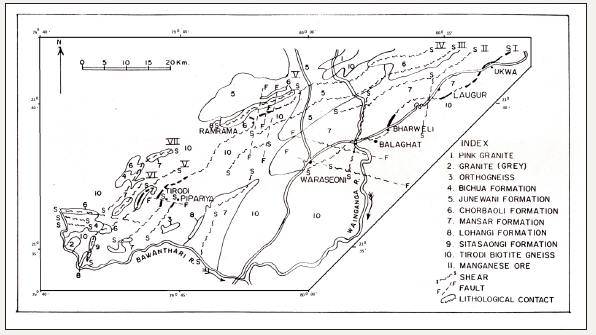
Metacarbonates
The calcareous metasediments of Sausars have maximum representation in the western part of Balaghat district [11]; (Figure 2). These white coloured metacarbonates have been classified as Bichua Metacarbonates. In addition, a small (0.75km x 0.5km) pinkish metacarbonate body occurring near Kharpariya (21041’:79042’) is correlatable to Lohangi Formation, owing to its pinkish white colour. Amongst the metacarbonate clusters, mention can be made of three major bands, each covering more than 15sq km of area, exposed within the gneissic (Tirodi biotite gneiss) country of this region. The metacarbonate band of Ambajhiri (21037’:79035’)-Hathigarh (21038’:79031’) is oriented along WNW-ESE trend and extends for more than 15km with an average width of 2.5km. The Piparwani (21040’:79034’) - Dhobitola (21042’:79039’) band extends in NE-SW trend for about 10km and has a maximum thickness of 1.5km. The third, Paraspani (21041’:79035’)-Pitesur (21045’:79037’) band, oriented NE-SW, extends for about 11km with an average width of 2km. Pasco (1950) has noted that the metacarbonates of this area contain minerals like forsterite, spinel, chondrodite, scapolite and wollastonite, and considered them to be representing separate varieties of marble. On Closer examination, it is found that these high temperature minerals are distributed along the peripheral part of the metacarbonate bands, as accessory constituents.
Figure 2:Geological map of part of topo sheet 55 O/10 [11].
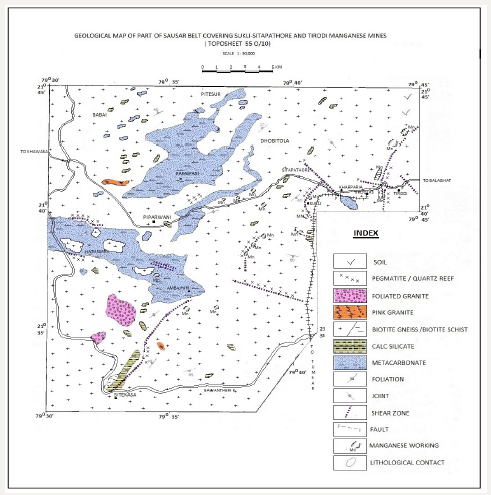
There is a tendency of decrease in abundance of these accessory minerals towards core. Central parts of all such metacarbonates bands exhibit a total absence of these high temperature accessories. Thus, the three major metacarbonate bodies, referred above, represent enrichment of calcite-dolomite-forsterite (partly serpentinized)- diopside-chondrodite-spinel-tremolite in peripheral part. While, the intermediate part lacks the presence of minerals like forsterite, scapolite, wollastonite and chondrodite and is comprised of calcitedolomite- diopside-tremolite-biotite-white mica and spinel. The core of such metacarbonate bands comprises calcite-dolomitetremolite -white mica and chlorite. This zonal arrangement of minerals is conspicuous in all the mapable metacarbonate bands of the area. Also, chondrodite, a common accessory of the outer zone, resembling garnet in physical appearance, and distinct in its anisotropism, is rare in the Paraspani-Pitesur band.
The outer high temperature zone extends for about 250m of width and grades into the intermediate zone of about 500m, before passing into a core of low temperature assemblage. The peripheral area, at places, become dark greyish green, just at the gneissic contact, showing predominance of diopside over calcite/dolomite, along with the accessories like quartz, sphene, epidote and calcic plagioclases with a characteristic granulose texture, inherited from the carbonates. Occasional appearance of wollastonite and/or scapolite, in such darker patches, is characteristic of the Paraspani-Pitesur band. These patches have striking textural and mineralogical similarity with the calc silicate lenses present within the surrounding biotite gneiss. The Ambajhiri-Hathigarh band hosts a small manganese occurrence, in close association with pink quartzo-feldspathic material, located 2.5km WNW of Ambajhiri. Small gneissic bodies, rich in white mica, also crop out at three locations within this metacarbonate body. As mentioned earlier, this white metacarbonate band has been correlated with the Bichua Formation by Narayanaswami and Venkatesh (op.cit).
In the surrounding of white metacarbonate lenses, a small pinkish white metacarbonate body is exposed in Dhoriya nala, south of Kharpariya (21041’:79042’). This body, also, is enclosed within biotite gneiss and is closely traversed by pink feldspar bearing quartzo-feldspathic material. Stretching and boudinaging of these quartzo-feldspathic veins (Figure 3) is indicative of ductile to brittle-ductile deformation. Horizontal disposition of the veins is attributable to later deformation. In strike continuity to the north, this tapering metacarbonate body is traceable to continue as calc silicate, intimately associated with quartzo-feldspathic veins. The metacarbonate body comprises calcite, dolomite, quartz, plagioclase, tremolite and white mica with minor amount of diopside, epidote, spinel and chondrodite. Development of diopside, spinel and chondrodite is more near the quartzo-feldspathic veins. Calc silicate, in strike continuity, comprises diopside, hornblende, calcite/dolomite, quartz and calcic plagioclases with minor amount of epidote, microcline, sphene and apatite.
The chemical analysis of the metacarbonates show high silica, high magnesium type with CaO variable between 24% and 36% (Table 1).
Table 1:Chemical analysis of metacarbonates from 55 O/10 (Courtesy GSI).
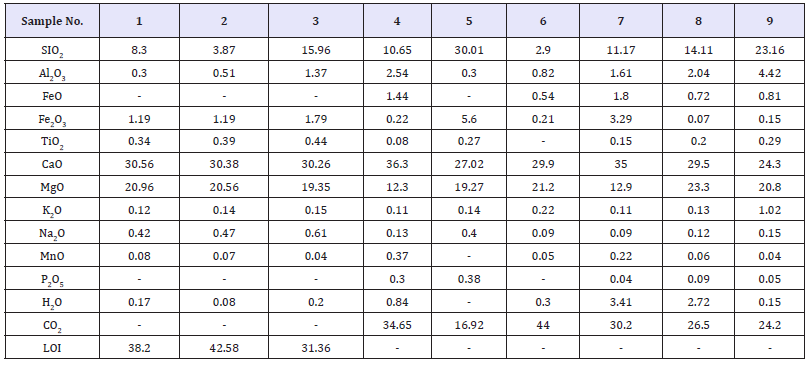
Calc Silicates
Calc silicate bands/lenses, embedded within biotite gneiss, have very high distribution in vicinity of the bigger metacarbonate bands discussed above. In general, there are innumerable lenses and bands of calc silicates distributed over the entire area. There is great mineralogical and textural similarity between the calc silicates occurring at peripheral part of metacarbonates, and the lenses and bands present within the enclosing biotite gneiss. Some of these lenses, present in vicinity of metacarbonate bodies, even have identifiable metacarbonate patches within them. Reference may be made of the Bawantheri dam, located at Sitecasa (210 32’:790 33’), where the river bed exposes thick (+10m) calc silicate enclosed within biotite gneiss. The sub surface data of the dam foundation, however, shows presence of metacarbonate in the core part of the calc silicate band. The calc silicates are light green to dark green or greyish green in colour, medium grained, and have a characteristic granulose texture. Though, banding is common in calc silicates, especially in the central and southern part, resulting from alternate bands of quartzose and mafic minerals (Figure 4); massive variety, especially in the northern part, is not uncommon. The banded variety often preserves angular folding (Figure 5), possibly indicating tangential movement along shear planes. Contact between calc-silicates and biotite gneiss is gradational, often having a hybrid zone of assimilation in-between. At many a places, especially in the northern part, dilation (Figure 6) of the calc-silicates, resulting from shear deformation, is conspicuous along the mixed zones.
The mineralogy of the calc silicate lenses is variable from the south to north (55 O/10), having corroboration with the regional metamorphic grades. The southern calc silicate lenses are represented by the assemblage hornblende-quartz-bytownite/ andesine/oligoclase/microcline-chlorite-epidote-sphene-apatite with or without calcite, indicative of low to medium grade of metamorphism. This is followed by the medium temperature diopside-zoisite-hornblende-epidote-quartz-bytownite-sphenecalcite- apatite-garnet rich assemblage of the central part. The northern calc silicate lenses are diopside and/or diopsie-augite rich, represented by the assemblage diopside-augite/hornblendebytownite/ andesine with or without quartz, garnet and sphene, indicating a high temperature regime. Though, hornblende is persistently present throughout the area, they appear to be after pyroxenes in the northern part. The line of first appearance of diopside is not very sharp as some of the calc silicate lenses, well within the southern part, show presence of diopside, much before the first appearance of zoisite, along with hornblende and epidote. Similarly, overlapping of the assemblages, for example, Diopside augite-quartz-bytownite-garnet bearing calc silicate occurring in the central part, and occurrence of zoisite bearing assemblage near the northern edge, is not uncommon. A granulose texture is common in all the varieties.
Figure 3:Exposure of pink metacarbonate in Dhoriya Nala, near Kharparia.
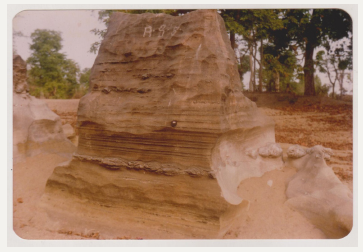
Figure 4:Exposure of banded calc silicate in Bawantheri river, near Sitekasa.
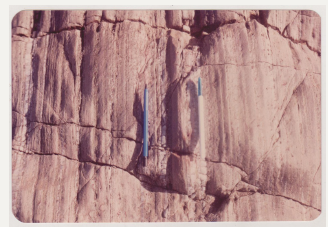
Figure 5:Angular folding in banded calc silicate. Loc. Bawantheri river, near Sitekasa.
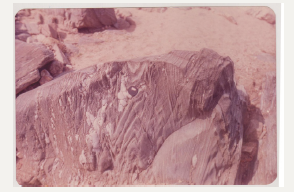
Figure 6:Dilation of calc silicate. Loc. North of Babai.
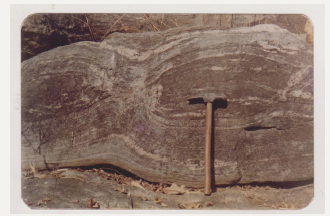
Chemical analysis of the calc silicates (Table 2) shows higher values of CaO, MgO and Fe2O3. Also, Na2O/K2O ratio of the calc silicates is approximately 2:1, not common for an igneous parentage. Analysis of garnets from the calc silicates showing high concentration of CaO, rather, is suggestive of a calcareous parentage (Table 3). Also, it is difficult to explain high CaO and MgO values of the calc silicates, if an igneous parentage for these rocks is contemplated.
Table 2:Chemical analysis of calc-silicates from 55 O/10 (Courtesy GSI).
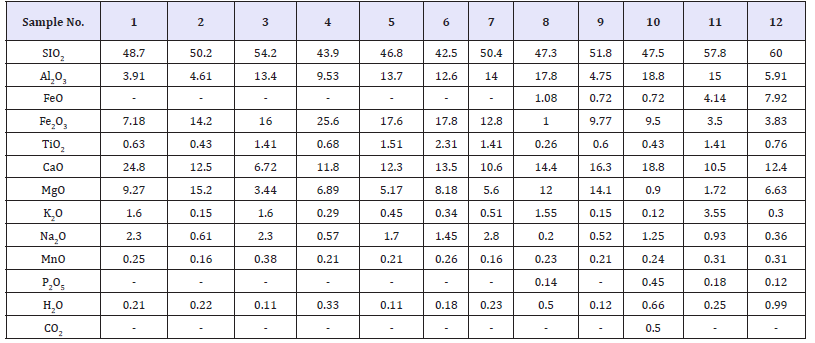
Table 3:Analysis of garnets from calc-silicates of 55 O/10 (Courtesy GSI).
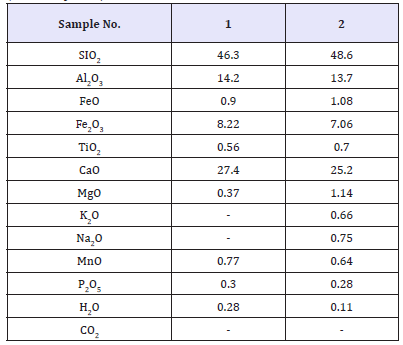
Biotite Schist/Granulite
The only mapable band (1.0km x 0.5km) of biotite schist/ granulite is present near Sitekasa, with a NE-SW trend, which grades to the north to biotite gneiss and to the south to calc silicate. The rock is sheared and closely folded, having straight limbs and sharp hinges (angular folds), with small lenticles of calc silicates in the closure part. Near calc silicate contact, the rock is medium grained, harder and saccharoidal in texture; while in core part the rock is coarse grained and shows development of biotite flakes in plenty. Near the gneissic contact towards north, numerous quartzose and quartzo-feldspathic veins, boudinaged and folded, traverse through the biotite schist, and the rock finally grades to biotite gneiss. Presence of biotite schist/granulite in minor scale, however, is ubiquitous bordering the numerously available calc silicate lenses. At such places also, the rock shows a saccharoidal texture near the calc silicates; while the outer margin is rich in coarse biotite flakes and grades to biotite gneiss. The biotite schist/granulite comprises quartz, biotite and oligoclase/andesine with accessory amount of apatite, calcite, tremolite, sphene and opaques. A granulose texture, defined by equigranular quartz and feldspars, is characteristic of this rock.
Biotite Gneiss
Biotite gneiss is the most abundant rock of the area, wrapping the metacarbonates and calc silicates, and has been classified as ‘Tirodi biotite gneiss’ [4]. This coarse to medium grained rock often shows ophthalmic structures and contain innumerable bands/ lenticles of calc silicates and biotite granulite and has abundance of metacarbonates, especially in this part of Sausars. Mineral composition and texture of the biotite gneiss frequently changes, influenced mainly by the presence or absence of the calc silicate/ biotite granulite patches and by ductile deformation. Amongst the textural variants, augen gneiss, banded gneiss, streaky gneiss and gneiss with granulose texture are common. At many places augen gneiss (Figure 7) and streaky gneisses (Figure 8) are product of ductile deformation. Whereas, schlieren rich biotite gneisses or the gneisses with ghost structures are produced by different degree of assimilation of the calc silicates/biotite granulite bodies.
Figure 7:Biotite gneiss showing shear deformation. Loc. Bawantheri river, east of Sitekasa.
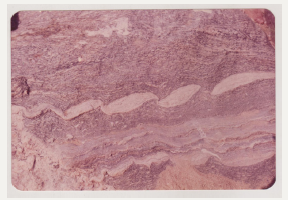
Figure 8:Streaky gneiss showing stretching of pink feldspar bearing QF veins. Loc. NW of Sitekasa.
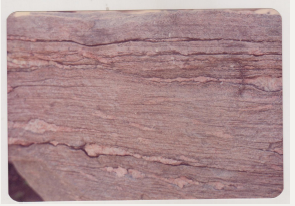
Figure 9:Tarney’s Diagram, showing plots of TiO2 Vs. SiO2 of biotite gneisses of the area.
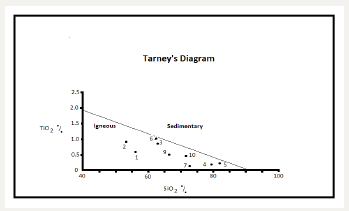
Biotite gneiss, in general, comprises quartz, perthite, microcline, oligoclase/andesine and biotite with minor amount of muscovite, apatite, sphene, calcite and hornblende. Presence of calcite and hornblende, however, is restricted near the metacarbonate and calc silicate contacts, respectively. Chemical analysis of biotite gneiss (Table 4) indicates higher values of CaO and MgO and higher K2O/ Na2O ratio (2:1). The rock is exceptionally rich in CaO and MgO near metacarbonate bodies. A plot of TiO2 against SiO2 in the ‘Tarney’s Diagram’ (Figure 9) shows an igneous origin for the biotite gneiss. Later intrusives of foliated greyish white granite and pink granite of very small dimensions also make their appearance in the southwestern part of the area.
Table 4:Chemical analysis of biotite gneiss from 55 O/10 (Courtesy GSI).
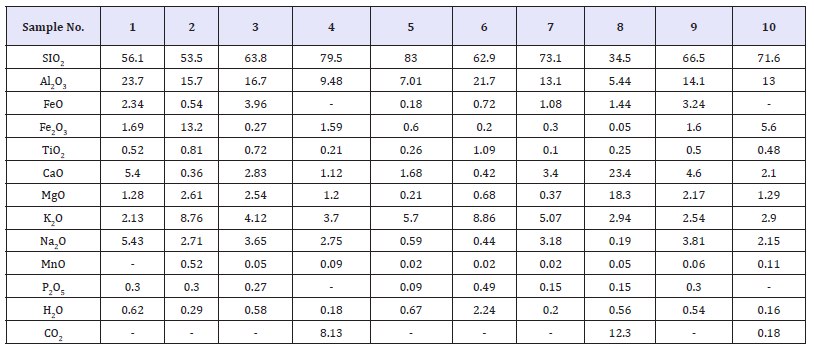
Shears
Shearing is a common phenomenon in Sausar terrain. Banerji et al. [5] have reported the presence of sinuous, folded, mylonite zones affecting the Sausar rocks of Balaghat. They advocated that the major shears of Sausars came into existence during waning face of F1 fold movement and were affected by later fold movements, responsible for imparting a sinuous map pattern to the mylonite zones (Figure 1). Existence of brittle-ductile to ductile shears, trending NE-SW to ENE-WSW, is common in the western part of Balaghat. Later brittle shearing along WNW-ESE and N-S trends, evidenced by large scale silicification and fracturing, has also affected the rocks of the area. Evidences, such as stretching and recrystallization of quartz along ‘S‘ and ‘C’ surfaces, rotation (anticlockwise) of the stretched boudins (Figure 7) and deformation of plagioclases by microfracturing, confirm that the shearing along the major zones were brittle-ductile to ductile in nature. Close association of the shears with the manganese deposits of Tirodi and Sukli-Sitapathore is strongly exemplified in the satellite imagery and is well proven on the ground.
Interpretation and Correlation
The mineral assemblages present in the metacarbonate bands are comparable to those of the assemblages of impure dolomitic limestone discussed by Rice [12]. Most of the metacarbonate bands represented in the area have zonal arrangement of these mineral assemblages. Low temperature assemblages occupying the core and higher temperature assemblages occupying the periphery indicate that, there existed a causative source of heat which wrapped the metacarbonates, during post depositional period. Presence of calc silicate/granulite patches in the metacarbonate periphery, and also within the enclosing biotite gneiss, indicate a direct link between them. Interestingly, smaller lenses of metacarbonates and of calc silicates find a high distribution within the biotite gneiss, in vicinity of bigger metacarbonate bodies. It is possible that these calc silicates represent a special variety of rocks, formed by metasomatic interaction between metacarbonates and the enclosing biotite gneiss, commonly known as ‘skarns’ [1]. Evidently, the saccharoidal/granular texture of the calc silicates is imbibed from the carbonates because of grain by grain replacement of the minerals during metasomatic changes. This well explains the presence of granulose texture even in low to medium temperature mineral assemblage bearing calc silicates of the southern area.
There is a northerly increase in regional metamorphic grade as explicitly depicted in Figure 1. The belt of low grade Mansar Formation, comprising phyllite and muscovite gneisses and schists, passes through the south-eastern part of the area, with a NE-SW trend. Biotitie rich, higher grade, Junewani Formation is present to the north, bordering the vast country of Biotite gneiss. Corroborating with the fact, the calc silicate lenses enclosed within biotite gneiss, also, show a general increase in regional metamorphic grade from south to north. In this context, the major metacarbonate bodies discussed above are restricted in medium to high temperature zone of regional metamorphism, as inferred from the mineral assemblages of the calc silicates present in the enclosing biotite gneiss. Notwithstanding, core part of all the three metacarbonate bands exhibit low temperature mineral assemblages, devoid of any effect of regional metamorphism.
West [3] advocated that none of the composite gneisses of northern Nagpur is older than the ‘Sausars Series’. They are rather, produced by intermixing of igneous material with pre-existing rocks. Large scale emplacement of anatectic melts into the Sausar metasediments, producing granitic gneisses, was also suggested by Phadke [13]. Present work reports an assemblage calcite-dolomiteforsterite- diopside-spinel-chondrodite from the metacarbonate periphery. The temperature estimate of such assemblage, according to Rice [12], is around 6000C, approximately equal to that of a granite pluton. At the same time, the zoisite bearing assemblages from the southern part and the diopside-augite bearing assemblages of the north, found in the calc silicates lenses, indicate a temperature range of 4000C to 6000C. This, together with the inferences made from ‘Tarney’s Plot’, is suggestive of an igneous parentage for the surrounding biotite gneisses of the area.
Thus, the evidences discussed above leads to a conclusion that, in all probability, a granitic melt got synkinematically emplaced within the pre-existing Sausars rocks. In absence of other lithounits, it is evident that those sediments were predominantly calcareous. Assimilation of these calcareous sediments, to the possible extent, made the resultant gneisses richer in Ca and Mg. The metacarbonate rafts and the calc silicate lenses are actually the thermally metamorphosed sediments which escaped assimilation. Signatures of thermal metamorphism and the metasomatic reactions in the peripheral regions of the metacarbonate rafts are some of the conclusive evidences towards this. Biotite granulites and biotite schists are also produced during this process, aided further by ductile/brittle ductile deformation.
As in the case of banded pink metacarbonate of Kharparia, where ductile deformation is responsible for the lit-par-lit injection of quartzo-feldspathic veins and for their further stretching, bandings present in calc silicates also could be attributed to the results of a similar process. The increasing grade of metamorphism of the calc silicates from the south-east, where major low grade Mansar meta-sediments predominate, to biotite gneiss dominated north-west (Figure 1) is possibly reflective of the temperature variation within the intruding granitic melt of large dimension. It is obvious to have lower temperature in the fringe area (SE) compared to the hot core (NW).
It is, therefore, arbitrary to attempt a chronological arrangement between the metasediments like white and pink metacarbonates, biotite schists, biotite granulite and the calc silicates. Occurrence of manganese, within the Ambajhiri-Hathigarh band, is also equally enigmatic. Such occurrences can only be explained if the concept of epigenetic origin for the manganese, as advocated by Banerji et al. [11], is brought in.
Acknowledgement
Authors express their sincere gratitude to Dr. Vinod Singh, Department of Geology, Bundelkhand University, Jhansi for allowing this paper to draw attention of the geological community. The authors also express their thankfulness to the Geological Survey of India for kindly permitting (1996) to use the data and geological maps for the research (Ph.D.) work of the first author. Gratefulness is also expressed to the departed soul of Late R.K. Singhai, who was instrumental behind this work and participated actively in the entire process of data collection.
References
- Yardley BWD (1989) An introduction to metamorphic petrology. Longman Scientific & Technical, pp. 126-146.
- Fermor LL (1909) The manganese ore deposits of India. Mem Geol Surv 37(4): 613-1287.
- Pascoe EH (1950) A manual of the geology of India and Burma 3rd edition, Manager of Publications, Delhi, India, p. 483.
- Narayanaswamy S, Venkatesh V (1971) The geology and manganese deposits of northern Bhandara district, Maharashtra. Bull Geol Surv Ind Ser A 22(4): 1971-2178.
- Banerji DC, Majumder S, Singhai RK, Shrivastava RK, Fulmari M (2007) Manganese mineralization associated with folded shear zones in Balaghat district, Madhya Pradesh. Jour Eco Geo and Georesource Management 4(1-2): 128-141.
- Straczek JA, Narayanaswami S, Subramanyam MR, Dhukla KD, Vemban NA, et al. (1956) Manganese ore deposits of Madhya Pradesh, India. Economic Geography 4: 63-96.
- Shukla KD, Anandalwar MA (1973) The geology and manganese ore deposits of the manganese belt in Madhya Pradesh and adjoining parts of Maharashtra: Part VIII - The geology and manganese ore deposits of the Balaghat-Ukwa area, Balaghat district, Madhya Pradesh. Bull Geol Surv Ind Ser A, India, p. 22.
- Fermor LL (1940) An attempt at the correlation of the ancient schistose formations of Peninsular India. Rec Geol Surv Ind 70(2): 230-231.
- Jain SC, Yedekar DB, Nair K (1990) A review of the stratigraphic status of Bharweli-ukwa manganese belt, Balaghat district, Madhya Pradesh. Geol Surv Ind Spl Pub 28: 332-353.
- Subramanyam MR (1972) The geology and manganese ore deposits of the manganese belt in Madhya Pradesh and adjoining parts of Maharashtra: Part IV-The geology and manganese deposits of the Ramrama- Sonawani area, Waraseoni Tehsil, Balaghat district and parts of Seoni Tehsil, Chhindwara district, Madhya Pradesh. Bull Geol Surv Ind, India, p. 22.
- Banerji DC, Shrivastava RK, Fulmari M, Singhai RK, Devrajan MK, et al. (1996) Final report on special thematic mapping of Sausar belt in parts of Balaghat and Seoni districts of Madhya Pradesh. Geol Surv Ind, Kolkata, India.
- Rice JM (1977) Contact metamorphism of impure dolomitic limestone in the Boulder Aureole, Montana. Contributions to mineralogy and petrology 59(3): 237-259.
- Phadke VA (1990) Genesis of the granitic rocks and status of the Tirodi Biotite Gneiss in relation to metamorphites of the Sausar Group and the regional tectonic setting. Geol Surv Ind 28: 287-302.
© 2018 Banerji DC. This is an open access article distributed under the terms of the Creative Commons Attribution License , which permits unrestricted use, distribution, and build upon your work non-commercially.
 a Creative Commons Attribution 4.0 International License. Based on a work at www.crimsonpublishers.com.
Best viewed in
a Creative Commons Attribution 4.0 International License. Based on a work at www.crimsonpublishers.com.
Best viewed in 







.jpg)






























 Editorial Board Registrations
Editorial Board Registrations Submit your Article
Submit your Article Refer a Friend
Refer a Friend Advertise With Us
Advertise With Us
.jpg)






.jpg)














.bmp)
.jpg)
.png)
.jpg)










.jpg)






.png)

.png)



.png)






